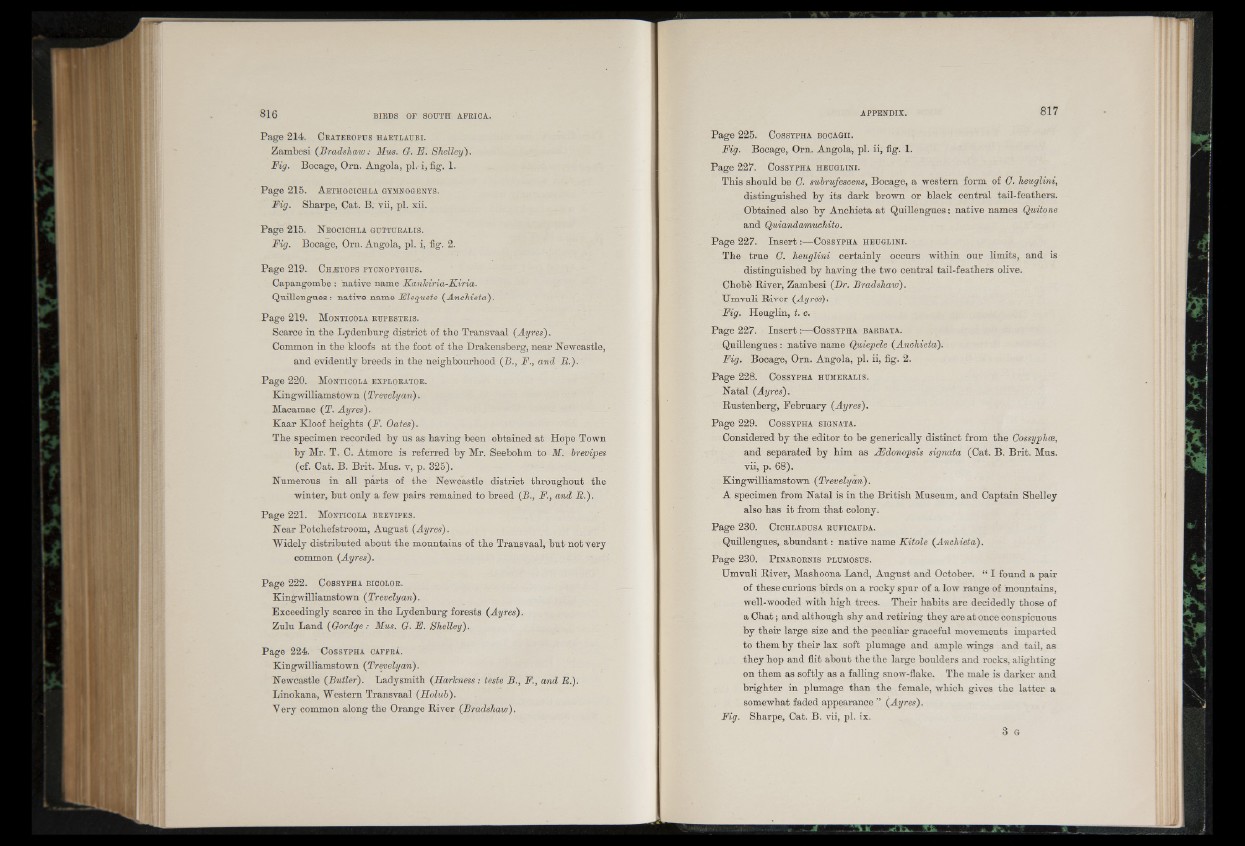
Page 214. C r a t e r o p u s h a r t l a u b i .
Zambesi (Bradshaw: Mus. G. E. Shelley) .
Fig. Bocage, Orn. Angola, pl.'i, fig. 1.
Page 215. A e t h o c i c h l a gymnogenys.
Fig. Sbarpe, Cat. B. vii, pi. xii.
Page 215. N e o c i c h la g u t t u r a l i s .
Fig. Bocage, Om. Angola, pi. i, fig. 2.
Page 219. C h ie to p s p y cn o p y g iu s.
Capangombe : native name Kankiria-Kiria.
Qnillengnes : native name Flequete (Anchieta).
Page 219. M o n t i c o l a r u p e s t r i s .
Scarce in tbe Lydenburg district of tbe Transvaal (Ayres).
Common in the kloofs a t the foot of the Drakensberg, near Newcastle,
and evidently breeds in the neighbourhood (B., F., and B.).
Page 220. M o n t i c o l a e x p lo r a to b .
Kingwilliamstown (Trevelyan).
Macamac (T. Ayres).
Khar Kloof heights (F. Oates).
The specimen recorded by us as having been obtained at Hope Town
by Mr. T. C. Atmore is referred by Mr. Seebohm to If. brevipes
(cf. Cat. B. Brit. Mus. v, p. 325).
Numerous in all parts of the Newcastle district throughout the
winter, but only a few pairs remained to breed (B., F., and It.).
Page 221. M o n tic o la b r e v ip e s .
Near Potchefstroom, August (Ayres).
Widely distributed about the mountains of the Transvaal, but not very
common (Ayres).
Page 222. C o s sy p h a b ic o lo r .
Kingwilliamstown (Trevelyan).
Exceedingly scarce in the Lydenburg forests (Ayres).
Zulu Land (Gordge : Mus. G. E. Shelley).
Page 224. C o s s y p h a c a f f r a .
Kingwilliamstown (Trevelyan).
Newcastle (Butler). Ladysmith (Ha/rkness: teste B., F., and B.).
Linokana, Western Transvaal (BLolub).
Very common along the Orange River (Bradshaw).
Page 225. C o ssy p h a b o c ag ii.
Fig. Bocage, Om. Angola, pi. ii, fig. 1.
Page 227. C o s sy p h a h e u g lin i .
This should be 0. subrufescens, Bocage, a western form of G. heuglini,
distinguished by its dark brown or black central tail-feathers.
Obtained also by Anchieta a t Quillengues: native names Quitone
and Quianda/nmchito.
Page 227. In s e rt:—C o s sy p h a h e u g l in i .
The true G. heuglini certainly occurs within our limits, and is
distinguished by having the two central tail-feathers olive.
Chobe River, Zambesi (Dr. Bradshaw).
Umvuli River (Ayres).
Fig. Heuglin, t. c.
Page 227. In s e r t||—C o s s y p h a b a r b a t a .
Quillengues: native name Quiepele (Anchieta).
Fig. Bocage, Om. Angola, pi. ii, fig. 2.
Page 228. C o s sy p h a h u m e r a li s .
Natal (Ayres).
Rustenberg, February (Ayres).
Page 229. C o s s y p h a s ig n a ta .
Considered by the editor to be generically distinct from the Gossyphce,
and separated by him as AIdonopsis signata (Cat. B. Brit. Mus.
vii, p. 68).
Kingwilliamstown (Trevelyan).
A specimen from Natal is in the British Museum, and Captain Shelley
also has it from th a t colony.
Page 230. C i c h l a d u s a r u f i c a u d a .
Quillengues, abundant: native name Kitole (Anchieta).
Page 230. P i n a r o r n i s plumo su s.
Umvuli River, Mashoona Land, August and October. “ I found a pair
of these curious birds on a rocky spur of a low range of mountains,
well-wooded with high trees. Their habits are decidedly those of
a C hat; and although shy and retiring they are a t once conspicuous
by their large size and the peculiar graceful movements imparted
to them by their lax soft plumage and ample wings and tail, as
they hop and flit about the the large boulders and rocks, alighting
on them as softly as a falling snow-flake. The male is darker and
brighter in plumage than the female, which gives the latter a
somewhat faded appearance ” (Ayres).
Fig. Sharpe, Cat. B. vii, pi. ix.
3 G